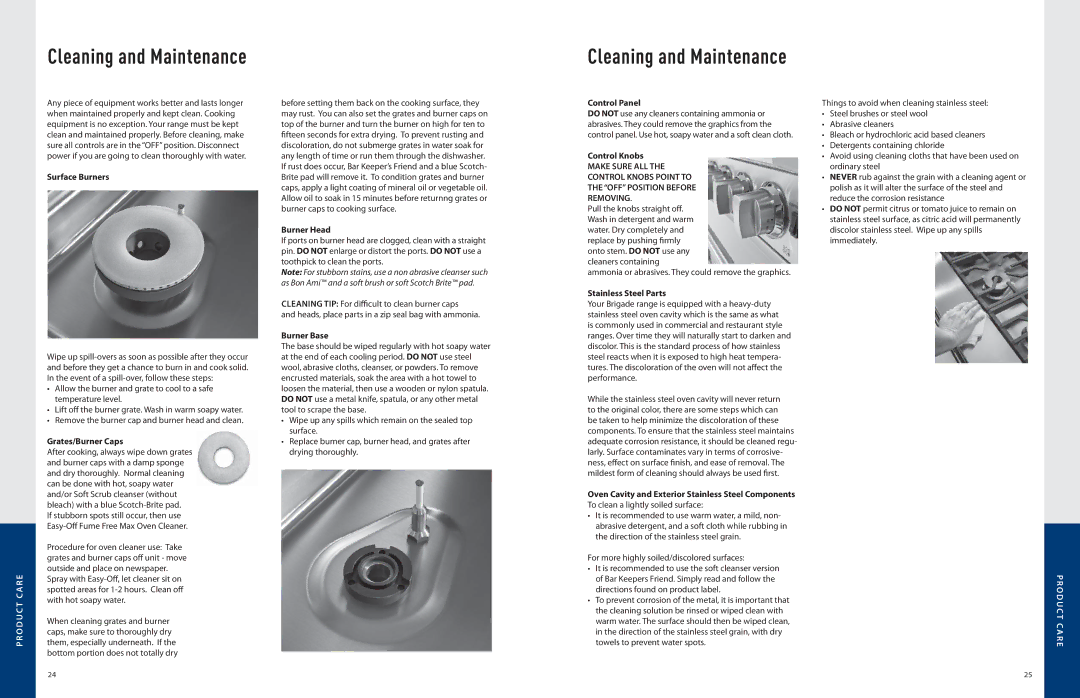Cleaning and Maintenance
Any piece of equipment works better and lasts longer when maintained properly and kept clean. Cooking equipment is no exception. Your range must be kept clean and maintained properly. Before cleaning, make sure all controls are in the “OFF” position. Disconnect power if you are going to clean thoroughly with water.
Surface Burners
Wipe up spill-overs as soon as possible after they occur and before they get a chance to burn in and cook solid. In the event of a spill-over, follow these steps:
•Allow the burner and grate to cool to a safe temperature level.
•Lift off the burner grate. Wash in warm soapy water.
•Remove the burner cap and burner head and clean.
Grates/Burner Caps
After cooking, always wipe down grates and burner caps with a damp sponge and dry thoroughly. Normal cleaning can be done with hot, soapy water and/or Soft Scrub cleanser (without bleach) with a blue Scotch-Brite pad.
If stubborn spots still occur, then use Easy-Off Fume Free Max Oven Cleaner.
Procedure for oven cleaner use: Take grates and burner caps off unit - move outside and place on newspaper. Spray with Easy-Off, let cleaner sit on spotted areas for 1-2 hours. Clean off with hot soapy water.
When cleaning grates and burner caps, make sure to thoroughly dry them, especially underneath. If the bottom portion does not totally dry
before setting them back on the cooking surface, they may rust. You can also set the grates and burner caps on top of the burner and turn the burner on high for ten to fifteen seconds for extra drying. To prevent rusting and discoloration, do not submerge grates in water soak for any length of time or run them through the dishwasher. If rust does occur, Bar Keeper’s Friend and a blue Scotch- Brite pad will remove it. To condition grates and burner caps, apply a light coating of mineral oil or vegetable oil. Allow oil to soak in 15 minutes before returnng grates or burner caps to cooking surface.
Burner Head
If ports on burner head are clogged, clean with a straight pin. DO NOT enlarge or distort the ports. DO NOT use a toothpick to clean the ports.
Note: For stubborn stains, use a non abrasive cleanser such as Bon Ami™ and a soft brush or soft Scotch Brite™ pad.
CLEANING TIP: For difficult to clean burner caps
and heads, place parts in a zip seal bag with ammonia.
Burner Base
The base should be wiped regularly with hot soapy water at the end of each cooling period. DO NOT use steel wool, abrasive cloths, cleanser, or powders. To remove encrusted materials, soak the area with a hot towel to loosen the material, then use a wooden or nylon spatula. DO NOT use a metal knife, spatula, or any other metal tool to scrape the base.
•Wipe up any spills which remain on the sealed top surface.
•Replace burner cap, burner head, and grates after drying thoroughly.
Cleaning and Maintenance
Control Panel
DO NOT use any cleaners containing ammonia or abrasives. They could remove the graphics from the control panel. Use hot, soapy water and a soft clean cloth.
Control Knobs
MAKE SURE ALL THE
CONTROL KNOBS POINT TO
THE “OFF” POSITION BEFORE
REMOVING.
Pull the knobs straight off. Wash in detergent and warm water. Dry completely and replace by pushing firmly onto stem. DO NOT use any cleaners containing
ammonia or abrasives. They could remove the graphics.
Stainless Steel Parts
Your Brigade range is equipped with a heavy-duty stainless steel oven cavity which is the same as what is commonly used in commercial and restaurant style ranges. Over time they will naturally start to darken and discolor. This is the standard process of how stainless steel reacts when it is exposed to high heat tempera- tures. The discoloration of the oven will not affect the performance.
While the stainless steel oven cavity will never return to the original color, there are some steps which can be taken to help minimize the discoloration of these components. To ensure that the stainless steel maintains adequate corrosion resistance, it should be cleaned regu- larly. Surface contaminates vary in terms of corrosive- ness, effect on surface finish, and ease of removal. The mildest form of cleaning should always be used first.
Oven Cavity and Exterior Stainless Steel Components To clean a lightly soiled surface:
•It is recommended to use warm water, a mild, non- abrasive detergent, and a soft cloth while rubbing in the direction of the stainless steel grain.
For more highly soiled/discolored surfaces:
•It is recommended to use the soft cleanser version of Bar Keepers Friend. Simply read and follow the directions found on product label.
•To prevent corrosion of the metal, it is important that the cleaning solution be rinsed or wiped clean with warm water. The surface should then be wiped clean, in the direction of the stainless steel grain, with dry towels to prevent water spots.
Things to avoid when cleaning stainless steel:
•Steel brushes or steel wool
•Abrasive cleaners
•Bleach or hydrochloric acid based cleaners
•Detergents containing chloride
•Avoid using cleaning cloths that have been used on ordinary steel
•NEVER rub against the grain with a cleaning agent or polish as it will alter the surface of the steel and reduce the corrosion resistance
•DO NOT permit citrus or tomato juice to remain on stainless steel surface, as citric acid will permanently discolor stainless steel. Wipe up any spills immediately.

